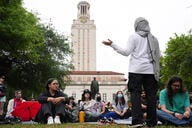You have /5 articles left.
Sign up for a free account or log in.
The other night, I had an eye-opening experience watching a cousin, a filmmaker and professor, work frame by frame with an undergraduate editing a TV pilot. The level of precision, focus and real-world application was striking—a sharp contrast to what most of us in academia do.
In his class, students don’t just learn about filmmaking in theory; they create industry-ready projects, collaborate in teams and receive direct professional feedback. The best work is showcased to industry executives and decision-makers, giving students an opportunity to see their work tested in real-world conditions.
This apprenticeship-style learning—intensive, immersive and high-stakes—offers insights into what all of higher education should strive for but rarely achieves. The film program’s approach is not just about technical mastery; it is about mentorship, hands-on learning and producing work that matters.
What Film Education Gets Right: High-Impact, Real-World Learning
Higher education is at its best when it fosters deep engagement, mentorship and real-world application. Too often, however, traditional university programs remain rooted in passive learning, abstract theoretical instruction and low-stakes assignments that fail to immerse students in the complexities of their chosen fields.
By contrast, film education offers a model for how universities can better prepare students for the realities of professional life. Film students do not simply study filmmaking in the abstract; they create, refine and showcase work that meets industry standards. They learn through a master-apprentice model, receiving direct mentorship from experienced professionals and they engage in high-stakes learning where their work is judged not just by professors but by industry leaders.
This approach is not only applicable to the arts but has valuable lessons for higher education across disciplines.
Beyond the Transcript: Producing Portfolio-Worthy Work
A student’s academic record should not be the only marker of their learning. Universities should ensure that every graduate leaves with a portfolio of meaningful, demonstrable work—projects that showcase practical expertise, intellectual depth and creative problem-solving skills.
This approach already exists in some disciplines but should be the standard across all fields.
- Architecture students leave school with a portfolio of meticulously designed buildings and urban plans, demonstrating their ability to conceptualize, model and refine real-world projects.
- Journalism students graduate with a collection of investigative articles published in professional outlets, rather than just writing theoretical essays.
- Business students in top programs develop real start-ups, pitch to investors and test ideas in the market, gaining hands-on experience in entrepreneurship.
- Computer science students in leading institutions build working apps, AI models or cybersecurity systems that solve real problems, rather than completing theoretical coding exercises.
- Engineering students design and build functional prototypes—bridges, robots, clean energy systems—that can be presented to industry leaders.
- Education students spend significant time designing and implementing lesson plans in actual classrooms, gaining firsthand experience as instructors.
- Nursing students don’t just memorize procedures—they practice clinical skills on real patients or high-fidelity simulations before entering the workforce.
In every case, the goal is clear: Students should graduate not just with a degree; they should graduate with work that proves their skills, expertise and readiness for professional success.
Master-Apprentice Learning: Coaching, Not Just Lecturing
In a world where higher education is often criticized for being overly theoretical and disconnected from real-world practice, the master-apprentice model of learning offers an alternative that is more immersive, engaging and effective.
Watching my cousin mentor his student through the intricate process of storytelling, cinematography and editing provided a striking contrast to traditional university teaching methods.
Rather than simply imparting abstract knowledge in a lecture, he was coaching, troubleshooting and refining a creative vision in real time. This hands-on, interactive approach ensured that learning was not just about acquiring information, but about mastering a craft.
While this model is deeply embedded in film programs, the fine arts and professional schools, it is underutilized in broader higher education.
Too often, students graduate with theoretical knowledge but little applied expertise, leaving them underprepared for the complexities of professional life. Universities must rethink how they approach teaching by incorporating more apprenticeship-style learning, where students gain real-world skills under the direct guidance of experienced mentors.
Where the Master-Apprentice Model Thrives
Some fields have long embraced learning through doing, integrating mentorship and hands-on practice into their curricula. These programs recognize that true mastery comes not from passive absorption of information but from guided experience, iterative feedback and direct engagement with real-world challenges.
- Medicine: Learning Through Clinical Rounds—In medical schools, students do not simply learn about anatomy, pathology and pharmacology in the abstract. They participate in case-based instruction, hands-on simulations and clinical rounds, working under the supervision of experienced physicians. This model ensures that by the time they enter the profession, they have not only theoretical knowledge but also the ability to diagnose, solve problems and make high-stakes decisions in real time.
- Law: Real-World Advocacy Before Graduation—Law schools take a similar approach, ensuring that students do not just study legal theory but also develop practical advocacy skills. The best programs integrate mock trials, moot courts, legal clinics and appellate advocacy competitions. Students argue before judges, represent real clients under faculty supervision, draft contracts and offer legal counsel.
- The Arts: Learning by Creating—In film programs, music conservatories and fine arts schools, learning is entirely project-based and mentor-driven. Instead of taking tests, students compose, perform and record original music under faculty guidance; choreograph and stage dance performances; create sculptures, paintings and digital art for gallery exhibitions; and direct, shoot and edit films that are showcased to the public.
Watching my cousin guide his student, frame by frame, through the process of editing a film underscored the value of real-time coaching and iterative learning. This is what deep education looks like—not just absorbing knowledge, but applying it, refining it and mastering it under the guidance of those who have already walked the path.
Where Higher Education Falls Short
Outside of professional schools and the arts, most university programs lack this kind of immersive, mentorship-driven learning. The result? Students graduate with abstract knowledge, minimal practical skills and limited professional readiness.
To prepare students for success, universities should infuse apprenticeship-style learning into every discipline, blending theoretical foundations with real-world application.
Integrating Mentorship into Undergraduate Education: Workable Strategies
While faculty members provide close mentorship to doctoral and honors students, the vast majority of undergraduates navigate college with minimal one-on-one academic and professional guidance. The challenge is not a lack of willingness on the part of faculty, but rather time constraints and institutional structures that do not prioritize mentorship at scale.
To bridge this gap, universities must integrate mentorship into existing educational frameworks, making it a structured, scalable and sustainable component of undergraduate education. Here are five workable approaches to incorporating meaningful mentorship without overwhelming faculty members:
- Expand faculty-led small seminars and learning communities: Increase the number of small, discussion-based seminars and thematic or career aligned or research-focused cohort programs—especially for first- and second-year students—where faculty can provide personalized guidance and academic mentoring.
- Implement peer mentorship networks: Create structured peer mentorship programs where upper-division students mentor first- and second-year students. Faculty can oversee and guide the program, ensuring quality mentorship.
- Build mentorship into capstone, research and project-based learning: Make mentorship a structured component of capstone projects, undergraduate research and interdisciplinary team-based courses.
- Require faculty office hour engagements with students: Require or incentivize students to attend office hours at least once per semester for a structured mentoring conversation.
- Create faculty-industry mentorship pairings: Faculty members can co-mentor students alongside professionals in related industries.
Make Mentorship Systematic, Not Accidental
Mentorship should not be a privilege for a select few students—it must be a structured, scalable part of undergraduate education. By embedding mentorship into existing courses, leveraging peer networks, integrating professional guidance and using technology strategically, universities can ensure that all students receive meaningful mentorship without placing unrealistic burdens on faculty.
Our goal should be to ensure that every undergraduate graduates with a faculty mentor, peer mentor and professional network, preparing them for both academic success and life beyond college.
Prioritize Collaborative, Real-World Problem-Solving
Higher education must evolve to reflect the realities of today’s professional landscape, where work is increasingly interdisciplinary, team-driven and project-based. In most traditional undergraduate programs, learning is highly individualized: Students sit through lectures, complete assignments independently and receive grades based on their personal performance. However, this model does not reflect how most complex, real-world problems are solved.
By contrast, film production offers a compelling alternative—one centered on collaboration, integration of diverse skills and iterative problem-solving. A successful film requires writers, directors, cinematographers, editors, sound designers, actors and producers, all working in synchronization to create a final product. No one individual completes the project alone; rather, it is the result of a deeply collaborative process where different forms of expertise must come together.
In a film production environment, students work in highly structured teams with clearly defined but interdependent roles. They iterate continuously, refining their work based on feedback and engage in interdisciplinary problem-solving, integrating storytelling, technology, design, business and logistics. They produce tangible, portfolio-worthy work that will be judged by industry standards.
The question then arises: How can we bring the collaborative, problem-based learning model of film production into the broader undergraduate experience?
Reimagining Undergraduate Education With Project-Based Learning
Instead of relying on isolated coursework and abstract assignments, universities should create cross-disciplinary, collaborative learning experiences that mirror real-world professional environments.
One of the most effective ways to introduce team-based problem-solving into undergraduate education is through cross-disciplinary projects where students from STEM, social sciences and humanities backgrounds work together.
- Engineering + Social Sciences + Public Policy: Engineering students design affordable housing solutions, while sociology and political science students analyze policy challenges and community impact.
- Computer Science + History + Art: Students create interactive historical simulations, combining programming, archival research and digital storytelling.
- Business + Environmental Science + Data Analytics: Students work with local governments to develop sustainability initiatives, using data modeling and policy analysis to propose solutions for climate adaptation.
These types of projects mirror real-world problem-solving, where diverse teams must integrate technical expertise, social awareness, ethical considerations and creative thinking.
Here are some other examples of collaborative, project-based learning in various disciplines.
- History: Instead of writing traditional research papers, history students could:
- Curate a museum exhibition that tells a compelling historical story through artifacts, visual media and interactive elements.
- Develop a public history project, such as an oral history archive, a community-based storytelling initiative or a historical walking tour app.
- Produce a documentary that investigates a historical event or figure, requiring research, scripting and interviews with historians.
- Political Science and Public Policy: Political science students could:
- Draft and propose actual policy recommendations for government agencies, think tanks or nonprofits.
- Simulate legislative negotiations where students take on roles as policymakers, crafting bills and debating real-world issues.
- Intern with advocacy organizations or city governments, applying their research to real legislative challenges.
- Psychology and Social Work: Students could:
- Design and conduct applied behavioral research, testing theories in community settings.
- Work in mental health clinics or crisis intervention centers, under supervision, gaining practical counseling experience.
- Create public health campaigns addressing issues like addiction, mental wellness or childhood development.
- Economics: Students could:
- Develop data-driven economic reports for local businesses or city planners.
- Conduct impact assessments of public policies and present findings to stakeholders.
- Use predictive modeling to analyze financial markets, presenting insights to investment firms.
- Literature and Writing: Literature and creative and nonfiction writing students could:
- Publish original works—short stories, novels, essays or investigative journalism—in literary magazines or news platforms.
- Develop digital storytelling projects, combining text, video and interactive media to create immersive narratives.
- Write and workshop screenplays that could be produced by student filmmakers or theater programs.
- Environmental Science and Sustainability: Students could:
- Design and implement sustainability initiatives—such as campuswide composting programs, urban gardens or renewable energy projects.
- Conduct environmental impact studies for local communities, addressing pollution, conservation or climate resilience.
- Create public outreach campaigns to educate citizens on environmental issues.
- Mathematics and Data Science: Students could:
- Use big data to analyze public health trends, financial markets or election results.
- Develop algorithms for machine learning models that solve real-world problems.
- Apply statistical analysis to social issues, such as education inequality, housing markets or crime rates.
What Universities Must Do to Make This Shift
Transitioning from passive learning to hands-on, high-stakes mentorship requires fundamental changes in how universities structure courses and assess students. Some key steps include:
- Redesign curricula around applied learning: Shift from lecture-based courses to studio-style, project-based or case-based courses that require students to produce real work.
- Expand faculty mentorship: Create opportunities for one-on-one coaching, small group workshops and direct faculty-student collaborations.
- Partner with industry and community organizations: Integrate externships, client-based projects and fieldwork into more courses.
- Require students to create public-facing work: Whether through published research, open-access data projects, creative exhibitions or start-up incubators, students should leave college with tangible, demonstrable expertise.
- Reimagine assessments: Move away from exams and essays that exist only within the classroom. Instead, require students to present findings, defend their ideas or create solutions with real-world impact.
Raising the Bar for What Learning Can Be
Watching my cousin and his student painstakingly edit a pilot frame by frame underscored a hard truth: Too much of higher education remains disconnected from how real expertise is developed. If universities want to prepare students for meaningful careers and leadership roles, they must embrace the intensity, mentorship and professional rigor that some of the best film programs exemplify.
Universities should move beyond knowledge transfer and incorporate more immersive, high-stakes and mentorship-driven learning models. Some ways to do this include:
- Ensure that students graduate with a body of work that showcases real expertise—not just a transcript.
- Faculty should spend less time lecturing and more time engaging students in deep, skill-building work that mimics professional practice.
- Whether through public presentations, industry partnerships or competitive selection processes, students should see their work tested in meaningful ways.
- Students should solve real problems together, producing work that is more than the sum of its parts.
Most of us in academia don’t teach like this—but we should.



